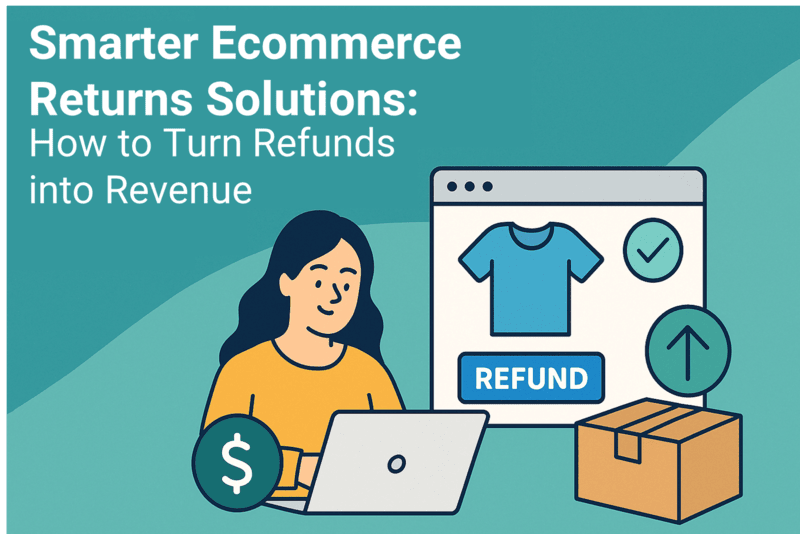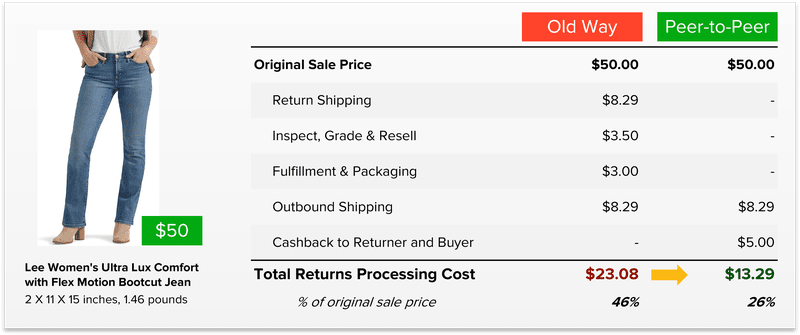Smarter Ecommerce Returns Solutions: How to Turn Refunds into Revenue

Last updated on April 16, 2025

In this article
 6 minutes
6 minutes
- Key Takeaways
- Why Ecommerce Returns Matter More Than Ever
- Common Causes of Ecommerce Returns
- Choosing the Right Ecommerce Returns Software
- Top Ecommerce Returns Solutions to Know in 2025
- Building a Customer‑Centric Returns Policy
- Sustainable Returns: Better for the Planet (and Your Profit Margins)
- Tech to Help You Reduce Returns (Before They Happen)
- Returns Don’t Have to Be a Loss
- Frequently Asked Questions
Returns used to be the headache nobody wanted to talk about. But in 2025, ecommerce returns are front and center, impacting profit margins, customer loyalty, and operational efficiency. With the average ecommerce return rate hovering between 15% and 30%, and return costs eating into revenue at every touchpoint, retailers are finally realizing that the right ecommerce returns solutions can make or break their business.
So, how do you stop bleeding revenue on returned items and start using returns to build stronger relationships with your customers?
Let’s dig into what works.
Key Takeaways
- Ecommerce returns are a major issue, with 30% of online products returned, leading to significant revenue losses, making effective returns management essential.
- Advanced returns management software can automate processes, prevent fraud, and integrate with existing systems to enhance efficiency and customer satisfaction.
- Implementing a customer-centric returns policy, including clear instructions, flexible windows, and incentives for exchanges, can significantly improve customer loyalty and reduce return rates.
Why Ecommerce Returns Matter More Than Ever
Returns aren’t just a cost, they’re a reflection of your customer experience. In fact, two‑thirds of online shoppers say they won’t come back after a bad return experience. For ecommerce businesses looking to grow repeat business and boost customer loyalty, that stat should ring alarm bells.
With ecommerce sales continuing to rise and online purchases becoming more frequent than in‑store shopping, the pressure is on for online retailers to offer seamless, fast, and transparent returns.
Common Causes of Ecommerce Returns
Returns in ecommerce often happen for predictable reasons:
- Wrong size or fit (especially in apparel and footwear)
- Product not as described
- Item arrived damaged
- Customer changed their mind
Most of these issues can be traced back to poor product descriptions, lack of sizing tools, or misaligned expectations. That’s where ecommerce returns solutions come in, not just to handle returns, but to prevent them in the first place.
Choosing the Right Ecommerce Returns Software
Today’s best returns management software does more than print a return label. It streamlines the entire post-purchase experience, from automating return authorizations to tracking inventory levels and preventing return fraud.
Key Features to Look For:
- Automation: Automate return approvals, generate prepaid return labels, and initiate refunds with minimal manual input.
- Integrations: Sync with your ecommerce platform, shipping carrier, inventory system, and customer service tools.
- Fraud Prevention: Flag suspicious return patterns and apply custom return rules.
- Analytics & Reporting: Gather data to understand your return rate by product, customer segment, and return reason.
- Flexible Refund Options: Let customers return for store credit, exchanges, or cash refunds.
If you’re not using returns software yet, you’re likely spending too much time and losing more revenue than you should.
Top Ecommerce Returns Solutions to Know in 2025
Here’s a quick rundown of a few standout solutions worth considering:
Cahoot
Cahoot’s peer-to-peer returns system is changing the game. Instead of sending returned items back to a warehouse, Cahoot enables the customer to ship directly to the next buyer. This cuts down on reverse logistics costs, shipping time, and inventory touchpoints, making it one of the most innovative ecommerce returns solutions today.
Happy Returns
This Shopify‑acquired service offers box‑free, label‑free drop‑offs at thousands of Return Bar locations. With fast processing and free return shipping, it’s a hit with online shoppers who crave convenience.
Loop
Loop’s software encourages customers to exchange rather than refund by offering bonus credit for swap‑outs. It’s a clever way to increase revenue retention and minimize lost sales.
AfterShip Returns Center
AfterShip helps online retailers automate the returns process and centralize returns data. Their system supports international returns, custom returns policies, and integration with major ecommerce platforms.
Building a Customer-Centric Returns Policy
A great returns policy isn’t just nice to have, it’s a sales tool. The right policy can influence purchase decisions and increase trust with potential customers.
A few tips for building yours:
- Offer store credit for exchanges and incentivize it with bonus credit.
- Keep it flexible. A 30‑day exchange window is standard, but extending it during holidays or for loyal customers can boost satisfaction.
- Use clear language. Your return policy page should be easy to read, prominently linked on product pages, and backed up with a helpful FAQ page.
- Offer printable shipping labels via an online portal.
And don’t forget, returns aren’t always bad. Customers who return items and have a good experience often become your most loyal.
Sustainable Returns: Better for the Planet (and Your Profit Margins)
Returns management isn’t just about cost, it’s also about brand reputation. As shoppers become more eco-conscious, your returns process is part of your sustainability story.
Here are a few ways to make your returns more sustainable:
- Refurbish and resell returned products whenever possible (ReCommerce is booming).
- Use eco‑friendly packaging for both outbound and return shipments.
- Offer returnless refunds on low‑cost items to avoid unnecessary shipping and waste.
- Reroute returns directly to future customers, like Cahoot’s peer‑to‑peer model, to bypass the fulfillment center altogether.
Tech to Help You Reduce Returns (Before They Happen)
Reducing your ecommerce return rate starts before the checkout button.
- Improve product descriptions: Be specific. Include dimensions, materials, and fit notes.
- Add more product images: Show items from multiple angles, in use, and on real people.
- Use AR/VR tools: Let customers preview furniture in their home or try on virtual glasses or clothing.
- Collect customer feedback: Monitor reviews and return reasons to spot trends and improve listings.
Gathering returns data and acting on it helps prevent future returns, increases customer satisfaction, and improves your product offering over time.
Returns Don’t Have to Be a Loss
If you’re still treating returns as an operational headache, it’s time for a mindset shift. Today’s best ecommerce returns solutions help online businesses turn returns into a driver of customer loyalty and business growth.
Whether you’re a store owner, a logistics manager, or a brand strategist, your returns strategy should be just as thoughtful as your marketing strategy. Done right, it keeps customers happy, saves time, reduces costs, and unlocks more revenue.
Let returns be your competitive advantage, not your liability.
Frequently Asked Questions
What is the average ecommerce return rate?
The average ecommerce return rate is between 15% and 30%, though it can reach 60% or more in certain categories such as luxury apparel. This highlights the importance of managing returns effectively in different product sectors.
How do returns impact customer loyalty?
Returns can build loyalty if handled well. A smooth, transparent return process increases trust and encourages repeat purchases.
Should I offer store credit or cash refunds?
It depends. Store credit encourages repeat business, while cash refunds increase trust. Many ecommerce stores offer both.
What’s the best way to prevent return fraud?
Use returns software that flags suspicious patterns. Require original tags, verify billing info, and offer store credit for questionable returns.
How do I choose the right ecommerce returns solution?
Look for software that integrates with your platform, automates your return flow, provides fraud tools, and offers robust analytics.

Up to 64% Lower Returns Processing Cost


